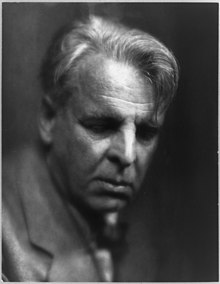The Ten Principal Upanishads is an English version of the Upanishads translated by the Irish poet W. B. Yeats and the Indian-born mendicant-teacher Shri Purohit Swami. The translation process occurred between the two authors throughout the 1930s and the book was published in 1938; it is one of the final works of W. B. Yeats.
 Photograph of W. B. Yeats during the long translation process for him and Swami's version of the Upanishads, c. 1933. | |
| Author | W. B. Yeats Shri Purohit Swami |
|---|---|
| Language | English |
| Published | 1938 |
Background
editIrish theosophist-writer George William Russell (also known as Æ) would often quote passages of the Upanishads to Yeats during their forty-year friendship and each time Yeats would say to himself: "Some day I will find out if he knows what he is talking about." The translations Yeats read (probably those by Anquetil-Duperron, themselves based on the Sirr-i-Akbar, a Persian version by the Mughal-mystic Dara Shukoh) left him incredulous, so upon meeting Shri Purohit Swami he proposed that the two of them of them translate the ancient text as though the original was written in common English,[1] quoting the following line from Aristotle as part of his motivation:
To write well, express yourself like the common people, but think like a wise man.
W.B. Yeats could not travel to India as planned, so the bulk of translation took place on the Western Mediterranean island of Majorca between the years 1935-1936, with the book finally being published in 1938. This bulk was during a time of rejuvenation for the health and creativity of W.B. Yeats (following a Steinach operation in 1934, performed by Australian sexologist-physician Dr. Norman Haire), as he notes in a 1935 letter: "I find my present weakness made worse by the strange second puberty the operation has given me, the ferment that has come upon my imagination. If I write poetry it will be unlike anything I have done".[2]
While Yeats only knew English, Shri Purohit Swami knew Sanskrit as well as English, Hindi, and Marathi. Yeats and Swami also communicated with one another via letters between the years 1931–1938. Although much of the correspondence concerns their translation of the Upanishads, W.B. Yeats also inquired about Shree Purohit Swami's life (including his nine-year pilgrimage across India) and the two shared conversation on many other topics, exhibiting a fond friendship cemented together by their mutual interests in mystical principles.[3] On 28 January 1939, Yeats passed away in Menton, France, less than a year after the publication of his and Shri Purohit Swami's translation of the Upanishads.[4]
Contents
editThe chapters are listed as follows:
- The Lord (Eesha-Upanishad)
- At Whose Command? (Kena-Upanishad)
- From the Kāthak Branch of the Wedas (Katha-Upanishad)
- Questions (Prashna-Upanishad)
- At the Feet of the Monk (Mundaka-Upanishad)
- At the Feet of Master Mandooka (Māndookya-Upanishad)
- From the Taittireeya Branch of the Wedas (Taittireeya-Upanishad)
- At the Feet of Master Aitareya (Aitareya-Upanishad)
- The Doctrine of the Chhāndôgyas (Chhāndôgya-Upanishad)
- Famous Debates in the Forest (Brihadāranyaka-Upanishad)
See also
editReferences
edit- ^ Yeats, W.B. (2003). The Ten Principal Upanishads. New Delhi: Rupa Publications. ISBN 9789386869487.
- ^ Letter to Dorothy Wellesley, 17 June 1935; cited Ellmann, "Yeats's Second Puberty", The New York Review of Books, 9 May 1985
- ^ "William Butler Yeats papers". library.udel.edu. University of Delaware. Retrieved 30 October 2020.
- ^ Obituary. "W. B. Yeats Dead". The New York Times, 30 January 1939. Retrieved on 21 May 2007.